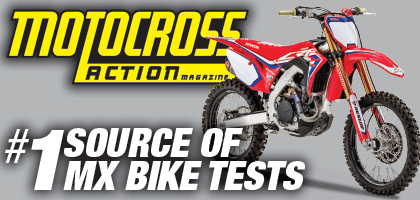MXA PERFORMANCE GUIDE TO THE 2011 SUZUKI RM-Z450

Week in and week out the MXA test crew logged moto after moto on our 2011 test and project bikes. We make certain that riders of every skill level and age group throw a leg over the bike. We want to know the best-performing, most practical and most cost-effective ways to make the bike faster, more durable and more enjoyable while considering all types of motocross riders. So, now that we are waiting for our 2012 RM-Z450, perhaps we need to look back at the 2011 RM-Z450. After all, the 2012 model is unchanged.
So, if you own a 2011 Suzuki RM-Z450 or the identical 2012 model, take a close look at MXA‘s comprehensive performance guide. MXA‘s performance guide isn’t a pricey parts list for a factory Suzuki bike. If money wasn’t an issue, it would be. It’s a compilation of practical modifications to help a racer get the most out of his investment. We give you all the information you’ll ever need for living with and loving the RM-Z450?without any of the ifs, ands or buts.

Fork springs. Suzuki made big strides in suspension settings for 2011. Straight off the showroom floor, the bike is rideable, but there is still plenty of room for improvement. The forks are still too soft for the average 450 rider. The Suzuki’s handling is already very aggressive, and having the forks dive into turns exacerbates the tendency to oversteer. We traded the stock 0.48 kg/mm springs for 0.49s and dropped the oil height from 377cc to 370cc.

Throttle tube. For all intents and purposes, the RM-Z’s throttle tube and throttle-side grip are a one-piece unit. Unless you really enjoy whittling, pick up an aftermarket unit. Motion Pro offers three options: The least expensive is a $10 nylon fabric composite. The second OEM replacement is an even tougher $25 plastic model dubbed the Titan that comes with a five-year crash warranty. The third and most expensive option is Motion Pro’s Revolver kit, which includes the throttle housing, throttle cable, throttle tube and multiple detachable throttle reels that allow for adjustable throttle response. The downside to the Revolver kit is that a bit more maintenance is required to keep it actuating smoothly after several hours of hard use.

Exhaust pipe. Fuel injection has made most modern four-strokes very jumpy from the first crack of the throttle. The Suzuki, however, has very smooth roll-on power. This can be a good trait in slick and hardpack conditions, but most test riders wanted more hit. We have been running a Pro Circuit Ti-4R exhaust system with an RC-4 header.

Heat protection. The RM-Z450 has always been prone to over-heating, especially when faced with sandy tracks, hot days, aggressive riders, big hills or mud. MXA has a four-part strategy to beat the heat. First, after each moto, we make sure that there is no mud obstructing the radiator louvers. Second, we don’t let the bike idle for a long time on the starting line. Third, we get a higher-pressure radiator cap from CV4. Finally, we keep the fuel from boiling by installing a heat insulator from CV4.

Clutch. The Suzuki’s clutch is weak. An aggressive clutch user will quickly overheat the clutch. Here are a couple of valuable RM-Z450 clutch tricks. (1) Stiffer aftermarket clutch springs are an inexpensive and effective solution, but nobody likes extra-stiff clutch pull. (2) A good compromise is to buy a set of firmer clutch springs and run half and half (with every other spring a stocker). (3) Never run an aftermarket clutch lever unless it has been specifically made for the Suzuki leverage ratio. RM-Zs have a higher leverage ratio than other bikes, and the traditional Honda leverage ratio of most aftermarket units won’t completely disengage the clutch. The plates will drag if the wrong lever.

Hot start. It’s not a question of if Suzuki’s right-side hot start lever will break, but when. We have broken them without crashing by smashing them with knee braces. DR.D and Works Connection both offer billet aluminum hot start replacements that we like and that have proven to hold up to collisions that would surely snap the stocker. For 2011, we put DR.D units on our RM-Zs and have had no trouble.


Handling. Suzukis are famous for their handling prowess in turns and infamous for nervousness on rough straights. Before doing anything drastic, take advantage of all the available adjustments on the bike. Together, these three things can get you safely through that section where you had the tank-slapper in practice. (1) The shock works best at 100mm of sag, but you can get away with dropping it to 105mm to help the chassis out. It effectively slackens the head angle and helps stability. (2) Lower the forks until the caps are flush with the top of the triple clamps. (3) Snug down the headset at the steering stem to act as a poor man’s steering stabilizer. You might be surprised that having it only slightly tighter is quite noticeable on the track.

Shifting. The RM-Z450 transmission isn’t always cooperative with the left foot, especially under load. Yoshimura’s ISF (Isotrophic Surface Finish) process reduces friction of the transmission gears, washers, spacers, shafts, shift fork, pins and shift drum. After this, your RM-Z will shift like butter and transmit more power to the rear wheel. The service is listed under their Stage 3 engine kit, but Yoshimura will perform the ISF process by itself for $230, which includes 15 parts. The major drawbacks are having to split the cases, take apart the transmission and wait the 7-to-10-day turnaround time.

Rear-end checklist. Periodically service the rear brake caliper, making certain that the pins and retaining clips are clean and properly aligned. Additionally, we don’t trust Suzuki’s axle blocks for chain alignment, since we have had RM-Zs where the block’s increment marks were way off. Measuring from the swingarm pivot to the rear axle ensures accuracy.

Chain-wear parts. The RM-Z450 eats its chain-wear parts very fast. You almost have to change the chain guide and swingarm buffer pad more often than the chain and sprockets. There is a better way. TM Designworks has scrutinized every detail and put a surprising amount of technology into a seemingly simple part. Their Factory 2 chain guide is made to flex, redirect force and lubricate, and it uses a replaceable insert. Plus, the bright yellow really stands out.

Chain roller. The RM-Z450 upper chain guide roller received a downgrade for 2011, as it no longer has a bearing to help it spin. To get the most out of the part you already have, you must grease it constantly. We opted to order a 2010 Suzuki roller. A smoother-spinning roller helps keep the noise down when the chain goes slack and bounces around over jumps.

Chain. We applaud Suzuki’s willingness to use a higher-quality O-ring chain, but we still replace it with a standard one after it wears out. Finally, it’s a good idea to use a torque wrench on the axle nut?if not every time, at least once in a while to remind your muscles how tight the nut is supposed to be.





Comments are closed.